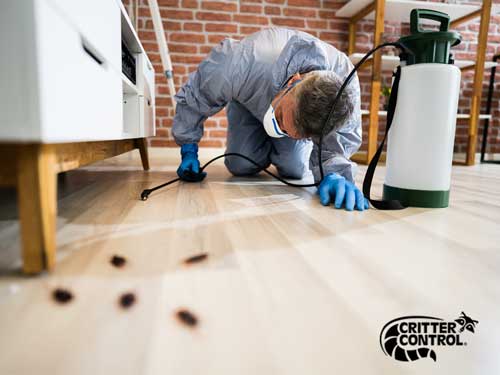High Quality A1 Pest Control Services Charlotte - Shield Your Home
High Quality A1 Pest Control Services Charlotte - Shield Your Home
Blog Article
Bed Pest Therapy Break Down: Contrasting Chemical Vs. Non-Chemical Solutions
In the world of bug control, especially when handling the relentless problem of bed bugs, the choice between chemical and non-chemical therapy solutions can be a critical one. Both approaches provide distinctive benefits and disadvantages, influencing elements such as efficiency, safety factors to consider, and general expense. By taking a look at the nuanced details of each approach, a more clear understanding of which path to pursue in resolving a bed pest problem can be achieved.
Effectiveness of Chemical Therapies
Chemical therapies for bed pest invasions have been extensively recognized for their rapid and potent efficiency in eliminating these parasites. When taking into consideration the performance of chemical therapies, it is important to understand that they can give a comprehensive and quick option to a bed insect trouble.
Furthermore, chemical therapies have the advantage of providing residual results, suggesting that they can proceed to eliminate bed insects even after the preliminary application. This residual action is especially valuable in combating any possible re-infestations. Furthermore, the fast activity of chemical treatments can bring relief to individuals encountering extreme bed pest problems, permitting them to gain back control of their living spaces rapidly.
Security Worry About Chemical Solutions
When making use of chemical solutions for bed bug treatment is ensuring the security of passengers and the setting,One vital element that needs careful factor to consider. While chemical treatments can be efficient in eradicating bed bugs, they might position dangers if not taken care of properly. One of the primary safety and security worry about chemical solutions is the prospective harm they can create to human wellness. Exposure to certain chemicals made use of in bed bug therapies can cause breathing issues, skin inflammation, or other unfavorable responses, especially in people with pre-existing problems or level of sensitivities. Furthermore, incorrect application or dosage of chemical pesticides can result in hazardous residues remaining in the cured area, posturing long-term health and wellness dangers to owners.
In addition, the ecological effect of chemical options is one more considerable factor to consider. Some chemicals used in bed bug therapies may be harmful to valuable insects, wildlife, and communities if they leach into the dirt or water supply. It is necessary to utilize chemical treatments deliberately, complying with safety and security guidelines, and considering much less toxic choices to reduce these dangers and make certain the safe and reliable monitoring of bed pest invasions.
Advantages of Non-Chemical Techniques
Considering the potential safety and security concerns and environmental effect linked with chemical services for bed pest treatment, discovering non-chemical strategies offers an appealing alternative with numerous distinctive benefits. Non-chemical treatments are eco friendly, as they do not contribute to air or water contamination, making them a lasting choice for parasite control.
In addition, non-chemical services can be efficient in targeting bed pests, including hard-to-reach areas where chemical treatments might not pass through - A1 bed bug exterminator charlotte. Techniques such as heat treatment, vacuuming, vapor cleaning, and bed mattress coverings provide extensive removal without the usage of hazardous chemicals.
Limitations of Non-Chemical Treatments

Furthermore, non-chemical treatments frequently call go to the website for several applications to attain successful elimination. This can be time-consuming and might not constantly ensure total elimination of all bed insects and their eggs, especially in hard-to-reach or covert locations.
In addition, the success of non-chemical treatments heavily relies upon appropriate application and thoroughness, which can be challenging for people without professional competence. Poor application of non-chemical methods may lead to incomplete obliteration, resulting in persistent invasions and the need for additional treatments.
As a result, while non-chemical treatments have their benefits, it is important to acknowledge these limitations and consider them when figuring out the most efficient method for handling bed pest invasions.
Expense Comparison: Chemical Vs. Non-Chemical Options
Provided the restrictions linked with non-chemical treatments, a necessary element to examine in the context of bed pest management is the cost contrast between chemical and non-chemical options. Chemical treatments normally involve the application of pesticides by specialists, which can range from $250 to $900 per room, depending upon the seriousness of the invasion and the size of the area to be treated. In comparison, non-chemical treatments like warm therapy or heavy steam can be extra pricey, with prices varying from $1,000 to $6,000 for a whole home. While the first price of chemical therapies may seem reduced, numerous therapies may be needed to completely remove the invasion, potentially raising the total price. On the various other hand, non-chemical options might give a much more eco-friendly and sustainable service, although they can be cost-prohibitive for some people. Ultimately, when taking into consideration the expense of bed pest therapy alternatives, it is important to consider the in advance expenses against the effectiveness and long-lasting sustainability of the selected approach.
Conclusion

Considering the possible safety and security problems check out here and environmental influence connected with chemical solutions for bed pest therapy, checking out non-chemical approaches presents a promising alternative with numerous unique advantages.Provided the limitations linked with non-chemical treatments, a necessary aspect to examine in the context of bed bug management is the price contrast in between chemical and non-chemical choices. In contrast, non-chemical therapies like heat treatment or heavy steam can be more costly, with costs varying from $1,000 to $6,000 for a whole home. While the first cost of chemical therapies might seem reduced, several therapies might be needed to totally get rid of the invasion, potentially raising the overall cost.In verdict, when comparing chemical and non-chemical bed insect treatment alternatives, it is vital to think about effectiveness, safety, benefits, constraints, and expense.
Report this page